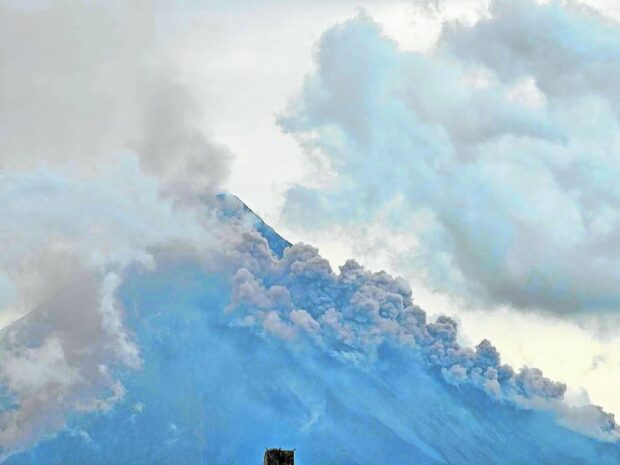Increased pyroclastic flow noted on Mayon

STILL RUMBLING | Mayon Volcano continuously generates pyroclastic density currents and lava flow as seen in this photo taken at 5:40 p.m. on Monday, July 10, 2023, in Daraga, Albay. The Philippine Institute of Volcanology and Seismology recorded increased activity on Monday morning due to lava dome collapse. (Contributed photo by DENNIS MIRABUENO)
MANILA, Philippines — The Philippine Institute of Volcanology and Seismology (Phivolcs) has recorded a sharp rise in the frequency of fast-moving volcanic flows at Mayon Volcano in Albay province on Monday.
In a volcano advisory issued on Monday, Phivolcs reported a total of 33 pyroclastic density currents (PDCs), from the four recorded on Saturday.
PDCs, which are dangerous flows of ash, rocks, and gases, traveled from one to four minutes down a 3.3-kilometer slope from the summit crater, Phivolcs said.
Sulfur dioxide emission, meanwhile, decreased to an average of 943 metric tons per day on Sunday, from the recorded 1,145 metric tons per day last Saturday.
Phivolcs also logged a jump from 26 volcanic earthquakes on Saturday to 109 on Sunday. The seismic energy release however remained at generally the same level since June 15.
Mayon remains under alert level 3 — which means an increased tendency toward a hazardous eruption — since it was raised on June 8.
“It is strongly recommended that the areas inside the 6-kilometer-radius permanent danger zone (PDZ) remain evacuated and that communities within the 7- and 8-kilometer-radius be prepared in case current PDC activity worsens,” Phivolcs said.
As of Monday, at least 5,765 families (20,148 people) from the PDZ were housed in different evacuation facilities in the towns of Malilipot, Sto. Domingo, Daraga, Camalig, and Guinobatan, and the cities of Tabaco and Ligao.
Cluster working group
On Monday, the provincial government of Albay announced that it created cluster working groups to start data collection to help in the recovery programs for the families affected by the unrest of Mayon Volcano.
Cedric Daep, chief of Albay Public Safety and Emergency Management Office, said the clusters would be working under the province’s Disaster Response Desk, recently created by Gov. Edcel Greco Lagman under Executive Order No. 63, that focuses on the humanitarian response plan and strategies in the delivery of support to the affected families.
Daep said there would be 12 clusters that would address issues related to agriculture, food, livelihood, camp coordination and management, early recovery, emergency shelter, nutrition, logistics, protection, environment and tourism, and health, water, sanitation, and hygiene.
He said the recovery plan would be put in place even as they were still attending to the needs of the displaced residents.
“Just like any other procedures and in disaster risk management application and governance, while we in the response phase, we are already starting the recovery phase to avoid overlapping of activities and not to cause in delays [in the] phase out of response to recovery,” Daep said at a press briefing on Monday.
The province had ordered the mandatory evacuation of families inside the PDZ on June 9, a day after alert level 3 was raised over the volcano.
Maria Vivien Cea, head of the provincial social welfare office, said the food and nonfood items were still sufficient in different evacuation sites as more aid arrived in the province.
US aid
Among those that came to the aid of the evacuees was the US government, through the US Agency for International Development (USAID), which has provided nearly P13 million to communities affected by the increased activity of Mayon Volcano.
The aid included more than P11 million ($200,000) in immediate humanitarian assistance and P1.86 million ($33,600) worth of education materials, the US Embassy in Manila said in a statement on Monday.
It said the USAID had partnered with the International Organization for Migration (IOM) to provide clean water, essential hygiene items, and emergency shelter to over 2,500 individuals in evacuation centers in the towns of Camalig, Guinobatan, Libon, Malilipot, and Sto. Domingo.
USAID and IOM will also help the local communities in managing evacuation centers and repairing critical water and sanitation infrastructure, the embassy said.
USAID also donated learner and teacher kits to 19 schools affected by the Mayon’s continued restiveness, benefiting some 6,000 students and 200 teachers.
With USAID support, the UN World Food Programme, in cooperation with the Department of Social Welfare and Development, also provided logistics assistance and transported around 58,000 family food packs to the evacuees.
The US Embassy noted that USAID works year-round with its Philippine partners to develop programs that enhance the country’s disaster preparedness and response such as the US Geological Survey’s Volcano Disaster Assistance Program.
The program offers hazard assessment training, early warning system development, and volcano monitoring equipment installation to disaster monitoring organizations like the Phivolcs, it said.